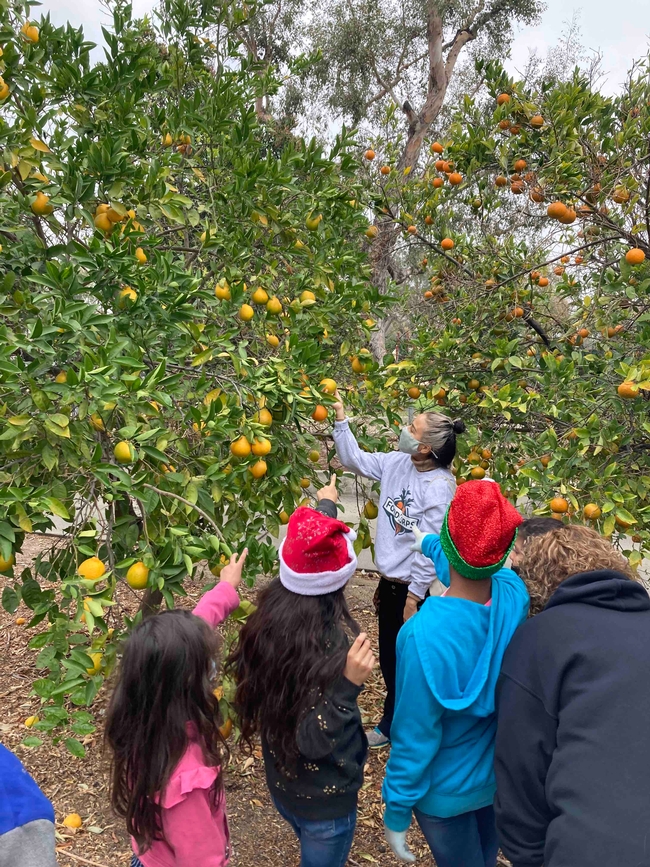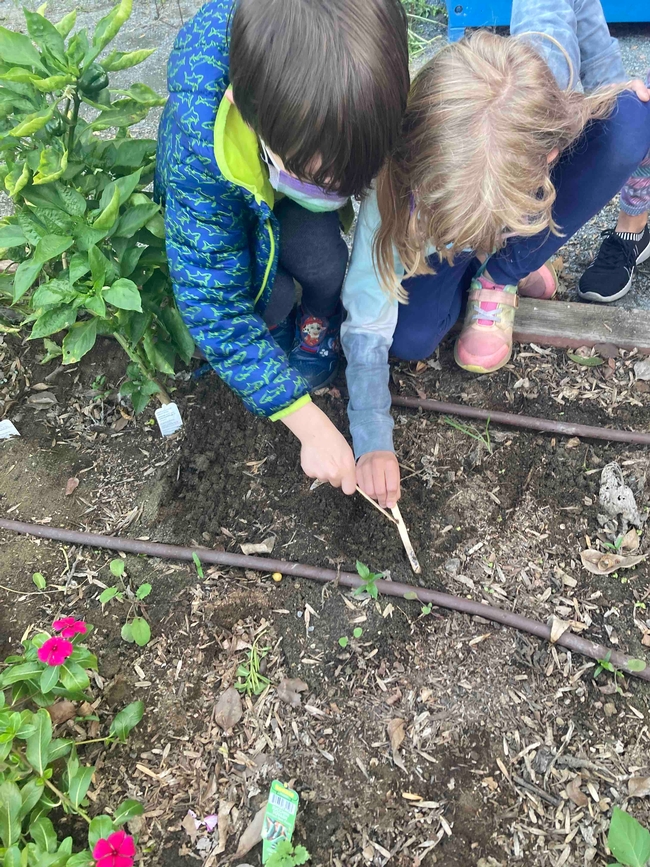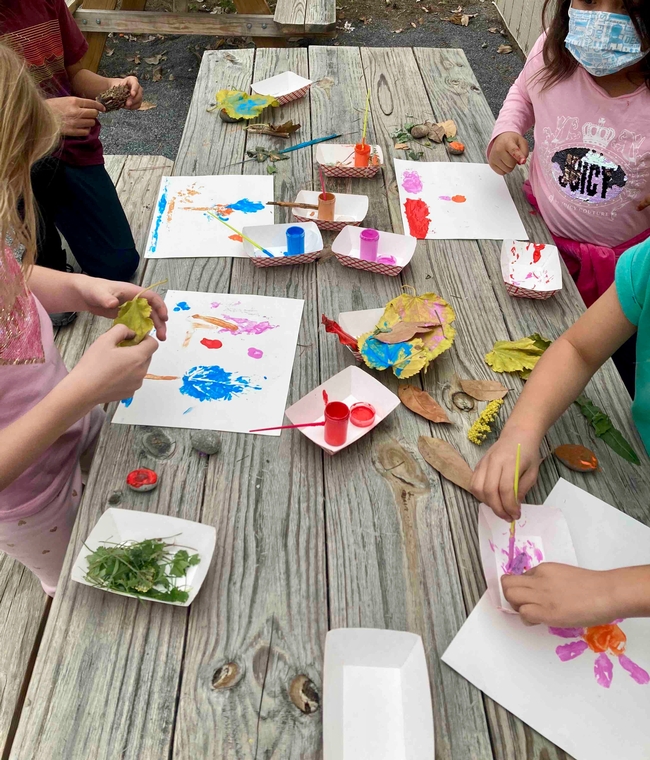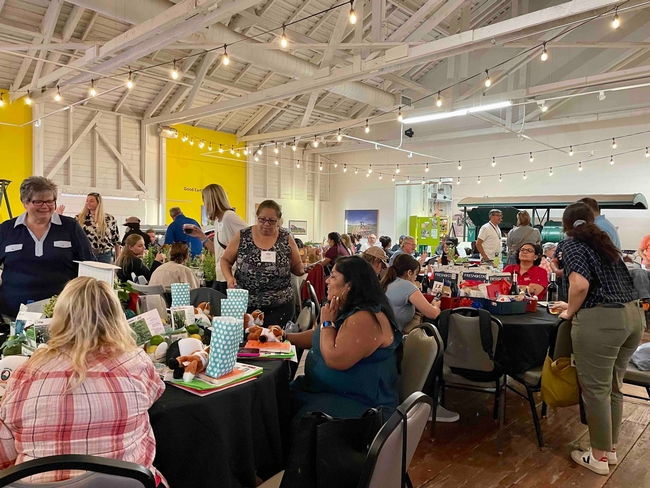- Author: Deborah Schnur
For the first time in three years, the California Agriculture in the Classroom Conference was held in-person this past September. Ventura County, with its rich agricultural heritage, was the perfect location for the conference to make its comeback. Growing up on the beaches of Long Island, New York, I was excited to attend the conference and spend some time by the shore. The conference agenda was filled with opportunities to learn and network through tours, presentations, exhibits, workshops, and discussions. Best of all, I returned home with three full bags of materials to use for school and environmental education.
Pre-Conference Tour and Reception
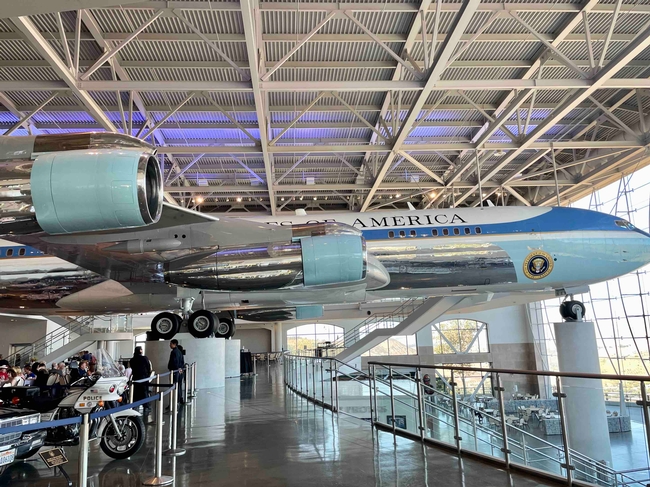
My second favorite part of the tour was walking through Air Force One and seeing how it was used during Reagan's time. The plane was retired after Reagan left office and moved to the site of the Library, where the building was constructed around it. The Air Force One Pavilion also houses vehicles from the presidential motorcade.
After the tour, I returned to the hotel for conference registration and a reception with Maureen McGuire,CEO of the Farm Bureau of Ventura County. I also took some time to network with exhibitors including the California Farm Bureau, California Women for Agriculture,Ventura County Farm to School, Students for Eco-Education and Agriculture (SEEAG), and the Ventura County Agricultural Museum.
Opening Session
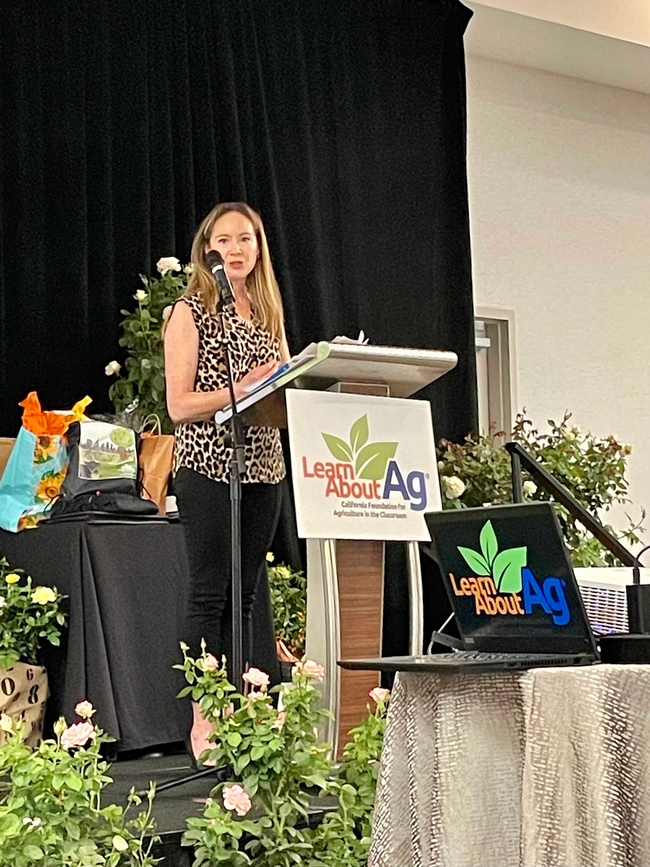
The last speaker was Christine Birdsong, the Undersecretary of the California Department of Food and Agriculture, who emphasized the importance of agricultural literacy for students and teachers. Because California has about 24 million acres of agricultural land and $20 billion in agricultural exports, the state's economic health is closely tied to agriculture. Agriculture is a growing career field that increasingly relies on technology, and a diverse group of young farmers is needed to replace those who are retiring.
Workshops
The opening session was followed by two workshop sessions. The first workshop I attended was “Youth Can Run a School Garden Program”, presented by Abbi Mars of UC CalFresh Healthy Living and students from Arthur Hapgood Elementary in Lompoc. I was inspired to hear how fifth and sixth grade students run all aspects of the school garden and teach younger students about gardening and nutrition. The student leaders rotate through different teams to learn about composting, fruit tree care, hydroponics, harvesting, and teaching. At the end of the workshop, the students gave a demonstration of the “Pest or Pal?” lesson from the CalFresh TWIGS (Teams with Intergenerational Support) curriculum.
My second workshop was “Bringing Gardening into the Classroom”, led by Veronica VanCleave-Hunt of CalFresh Healthy Living. She and her colleague presented three TWIGS garden lessons that can be taught in the classroom without a garden. The first lesson was “Seed Magic” where students dissect a seed and identify the parts. The workshop attendees received lima bean seeds that had been soaked in water and were instructed to remove the seed coat and identify the leaves, root, and cotyledon (food source). Who knew a simple seed could be so interesting?
The second lesson was “Soil” where we used our senses to observe the soil components of sand, silt, and clay. Then we learned how to conduct a soil test by mixing a soil sample with water in a jar and watching the layers separate. The final lesson was “Eat Your Plants” about how food can come from all plant parts: roots, stems, leaves, flowers, fruits, and seeds. The workshop instructors passed around bags, and the attendees tried to identify the fruit or vegetable inside and the plant part.
After the workshops, we were treated to a hearty lunch and an engaging talk from Coach Kiah Twisselman Burchett, “Grow Through It: Blooming Through Hardship”. Coach Kiah is a cattle rancher turned motivational speaker who shares her triumphs and struggles with body image and weight loss to empower others to find joy in life.
Field Trips and Taste of California Dinner
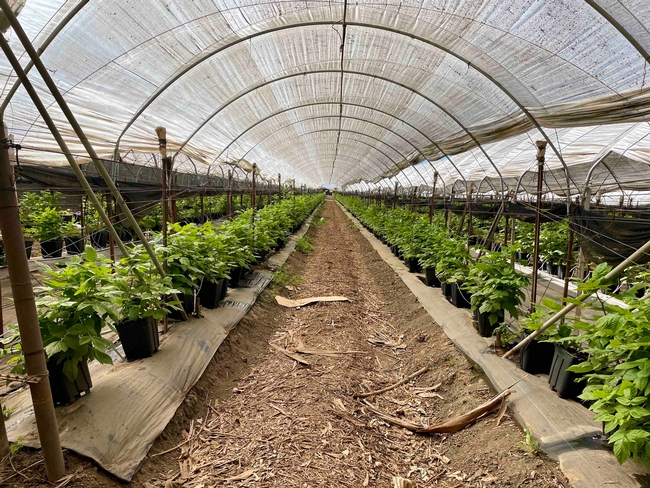
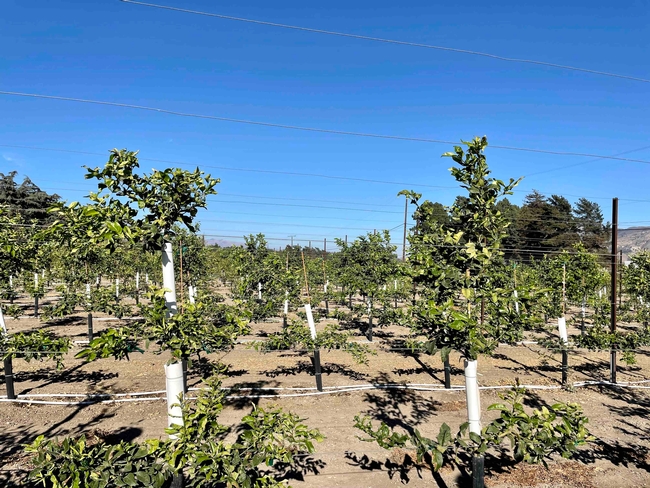
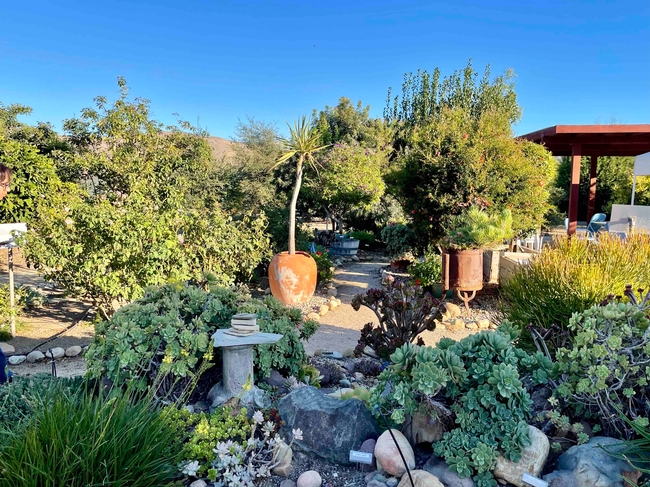
The day ended with the Taste of California at the Ventura County Agriculture Museum in Santa Paula. Each of the 13 tables was decorated according to a theme by a host organization. Hosts ranged from the Santa Paula High School Ag Department to the California Farmland Trust. I opted for the “CA Central Coast Cornucopia of Freshness” table hosted by the California Women for Agriculture, Ventura County. After a welcome from Shannon Douglass of the California Foundation for Agriculture in the Classroom, Coach Kiah took the reins as the emcee for some table games. At the end of the night, I filled a bag with take-home gifts of seeds, citrus, trail mix, and local Blue Ridge honey from my table host.
Closing Sessions
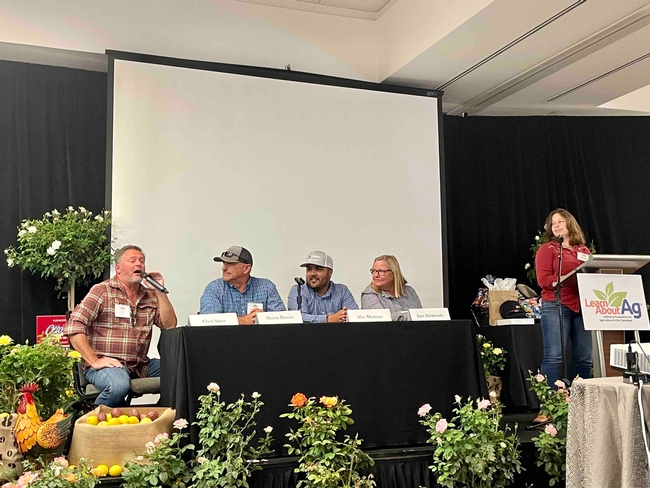
After the panel were the Make ‘n Takes, 20-minute activities to share with students. During the Beads and Books session, I made a daisy beaded bookmark from natural materials. From the Orange You Glad We Have Farmland? session, I learned the percentage of land available to grow food for the world–only 3 percent! The MyPlate Nutrition activity demonstrated ways to introduce the five food groups to students and help them list foods in each group.
I was sad to see the California Ag in the Classroom Conference come to an end but happy to spend a few hours on the beach before heading home. Next year, I look forward to attending the state conference again and maybe even the national conference in Orlando! If you're involved in agriculture education, I highly recommend checking out the resources that Ag in the Clasroom offers at https://learnaboutag.org and https://agclassroom.org.
Have you enjoyed reading this blog? Do you have questions? Need help with school gardens or environmental education? If so, send an email to dschnur@ucanr.edu. I look forward to hearing from you.
- Author: Deborah Schnur
FoodCorps has held a special place in my heart ever since I served as a FoodCorps service member at Phelan Elementary during the 2019-2020 school year. It was hard work and also immensely rewarding to connect kids with healthy food and share the joy of gardening. I loved seeing the smiles on students' faces when they harvested their first tomato from the school garden and tasted their first “rainbow” smoothie.
FoodCorps' Work
FoodCorps' mission is to “partner with schools and communities to nourish kids' health, education, and sense of belonging.” Their vision is that “every child, in every school, experiences the joy and power of food”. As a member of the AmeriCorps network, FordCorps provides leadership and educational opportunities for service members in limited-resource communities. In addition, FoodCorps advocates for policy change to promote equity and sustainability in the school food environment.
The Service Member's Role
Service members must complete at least 1700 service hours during an 11-month term. They are paid a living stipend and receive a Segal Education Award after successfully completing their term. Those who serve in California also receive a California for All Education Award.
FoodCorps service members focus on three main areas of impact: leading hands-on lessons, influencing nourishing school meals, and building a schoolwide culture of health. In the first area, they teach students to grow, prepare, and taste new foods with interactive lessons linked to academic standards. To influence school meals, service members conduct taste tests, promote healthy food choices in the cafeteria, and work with school district administrators and staff to add local foods to school meals. To build a culture of health, service members collaborate with the entire school community–including teachers, administrators, and families–to plan activities such as family cooking nights and garden work days.
Master Gardeners Help with Garden Training
FoodCorps service members start the school year with a wide range of gardening and farming experience. Some have majored in agriculture, and others have grown only houseplants. Most are expected to start or maintain gardens at the schools where they serve.
To provide their service members with a basic level of gardening know-how, FoodCorps site supervisors in Los Angeles (Rachel Black), Upland (Cassidy Furnari), and San Diego (Janelle Manzano) planned a joint garden training class. Cassidy, the Upland Unified School District (UUSD) Farm to School Manager, asked the San Bernardino County Master Gardeners to help deliver the training at Baldy View Elementary, which has an extensive vegetable garden, native plant garden, and orchard. Maggie O'Neill, the Master Gardener Coordinator, and I were excited to accept the challenge and prepare for the class.
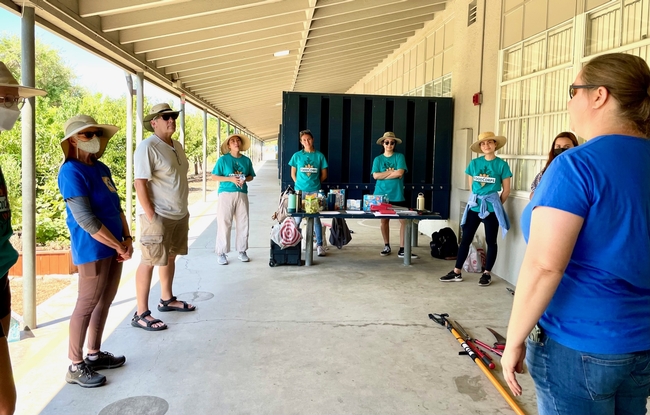
For the next half-hour, I led a hands-on demonstration of how to teach composting to students. I asked the service members to line up and add greens (food waste) to the compost bins followed by browns (mulch). Then everyone took turns watering the compost piles and turning them with shovels. That's all there was to it! To continue the decomposition process, compost needs to be watered and turned on a regular basis. For reference, I gave the service members copies of a composting resource sheet and my favorite compost guide from LA Compost.
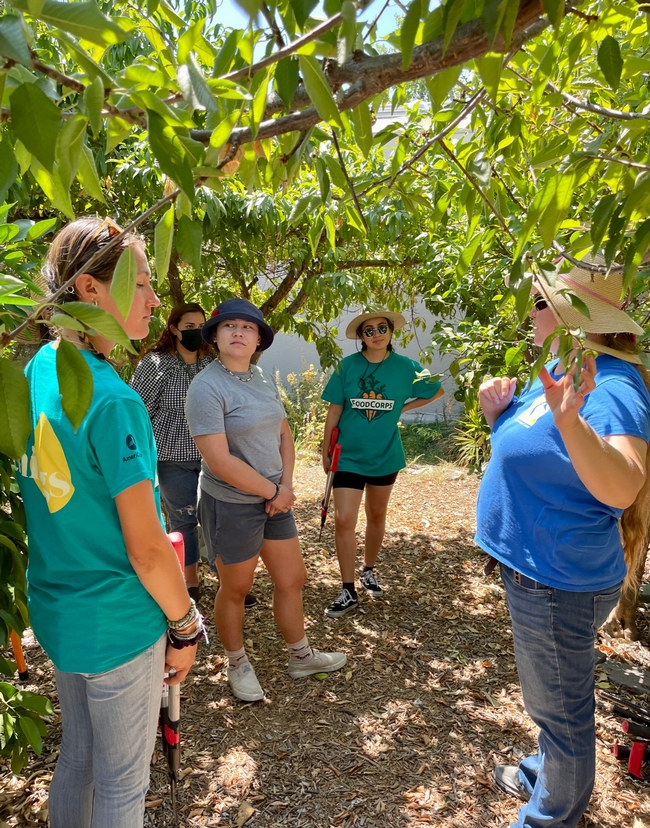
After the training, the FoodCorps service members, site supervisors, and Master Gardeners gathered for a healthy lunch including figs, tomatoes, cucumbers, and squash harvested from the Upland school gardens. A fitting end to a productive day! I hope this experience inspires some of the service members to become Master Gardeners in the future.
Meet the Upland USD FoodCorps Service Members
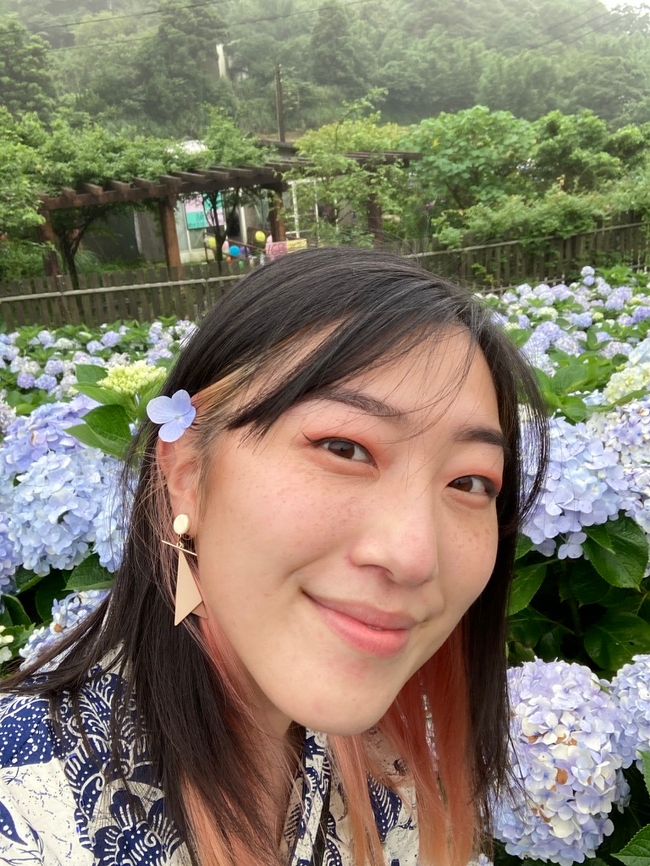
Valerie Tu has returned for a second year with FoodCorps after spending a year as a Fullbright Scholar and English Teaching Assistant in Taiwan. She is teaching at Baldy View Elementary and Citrus Elementary. During her first year at UUSD in 2020-2021, Valerie's interaction with the students was entirely virtual due to the COVID-19 pandemic. Valerie graduated from the New York University Gallitin School of Individualized Study with a Bachelor of Arts, concentrating on the politics of food. While studying at NYU, she also worked as a farm operations intern, a resident assistant, and a culinary intern at the Museum of Food and Drink among other activities.
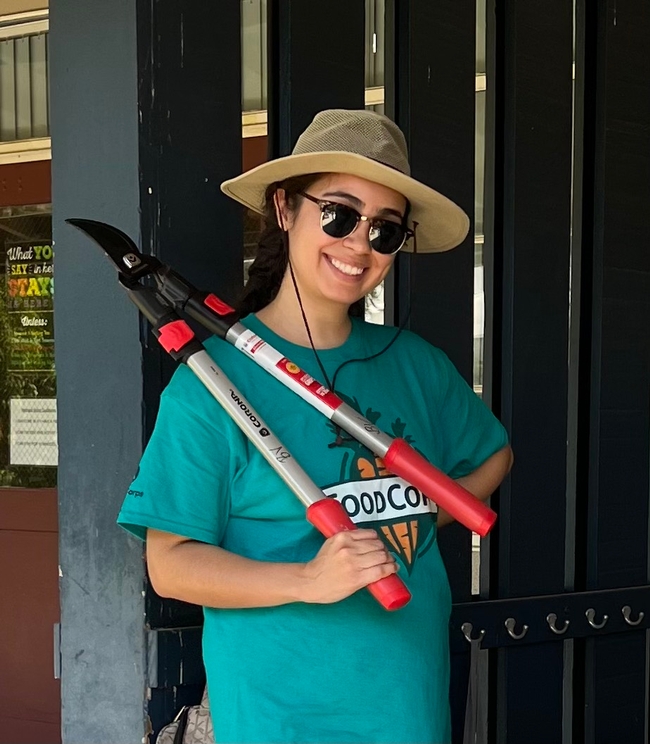
FoodCorps' Impact
I am so grateful to Valerie, Meagan, and all the FoodCorps service members who devote a year or more to promoting food justice in schools and communities across the county. Last school year, FoodCorps service members taught 15,000 lessons, led 6,000 food tastings, and supported over 350 gardens nationwide. In four Upland schools, approximately 1,400 students received biweekly FoodCorps programming, and nearly 2,000 students participated in lunchtime activities and engagement during the school year. Through these types of hands-on learning activities, service members will help FoodCorps reach its goal for every child to have access to food education and nourishing food in school by 2030.
Have you enjoyed reading this blog? Do you have questions? Need help with school gardens or environmental education? If so, send an email to dschnur@ucanr.edu. I look forward to hearing from you.
- Author: Deborah Schnur
In April, I attended the Growing School Gardens Summit in Denver, Colorado, thanks to support from UCCE San Bernardino. The conference was promoted as “a gathering to inform, inspire, and invigorate the school garden movement” and was hosted by the Sprouts Healthy Communities Foundation in partnership with LifeLab and the School Garden Support Organization (SGSO) Network. It was so exciting to meet school garden educators and influencers from across the country and return home with a suitcase full of seeds, handouts, business cards, and healthy snacks to motivate me for months to come! In this blog, I want to share my most memorable moments from the conference and give you an update on the Upland High School waste audit.
Growing Garden Leaders

Monthly webinar topics included planting with students, culinary connections, garden maintenance, seed saving, and composting. To keep trainees engaged remotely, a variety of tools and techniques were used: guest speakers, school and teacher spotlights, live demonstrations, breakout rooms, interactive group platforms, activity kits, Q&A sessions, and a social media group. I'm always looking for more tools to add to my environmental education toolbox! In addition, this type of “train the trainer” framework could be useful for our Master Gardener School Garden Committee.
Providing Effective Support to School Gardens
The “Growing Garden Leaders” workshop dovetailed nicely with another workshop held on the last day of the conference. “Providing Effective Support to School Gardens in Your Region” showed how to increase the impact and effectiveness of garden-based activities with limited capacity. Presented by the United States Botanic Garden and the Office of the State Superintendent of Education (both in Washington, D.C.), the session introduced the Multi-Tiered System of Supports (MTSS) framework. This approach advocates building a strong foundation of “tier 1” activities that are available to everyone and disseminated widely. About 80 percent of those served will get what they need from tier 1. Two examples are a school garden guide and a monthly newsletter. The remaining 20 percent will need more support from tiers 2 and 3 such as group training or a site evaluation. This concept resonated with me because our School Garden Committee just finished adding school garden resources to the Master Gardener website, a tier 1 activity. Now we have a place to refer those who contact us for help.
Decomposition!
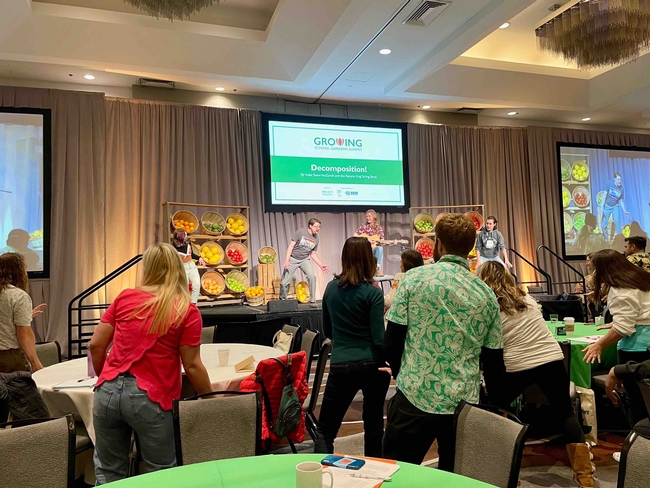
Edible Schoolyard New Orleans
Staff from Edible Schoolyard New Orleans gave two excellent short talks. Sasha Solano-McDaniel discussed how a Spanish cooking club enabled language acquisition in the kitchen classroom. Both English language learners and native English speakers benefitted from sharing their cultures and building community. Brian Tome outlined how he created a resilient, undemanding, and educational garden at the Phillis Wheatley Community School. He accomplished this by planting cover crops and perennials and creating a food forest using plants common in the tropics and subtropics such as taro, ginger, turmeric, papaya, and lemongrass.
Food Forests for Schools
My favorite presentation of the conference was “Food Forests for Schools” presented by The Education Fund, a non-profit organization that provides leadership and support for public education in Miami-Dade County, Florida. Food forests are multi-layered food growing systems consisting of trees, bushes, herbs, vines, and ground covers. In Miami-Dade County, 26 of the 51 elementary schools have perennial, edible landscapes that provide food for students to take home and eat in the cafeteria.
Through the Edible Outdoor Eco-Labs to Accelerate Learning program, The Education Fund installs food forests and shows schools how to use them as outdoor classrooms to teach science and nutrition lessons. The main design elements of the food forest are a defined entrance, walking paths, an outdoor classroom, and a compost circle surrounded by banana trees. I would love to see this type of design used in more school gardens in Southern California. Many tropical plants that grow in South Florida can also grow here at lower elevations.
Building a Sustainable School Garden Program
In “Building and Institutionalizing a Sustainable School Program”, Dan Brown, a junior/senior high school teacher in rural Northern California, described how he and his students started with an existing greenhouse to build a garden program that now sells about 2000 pounds of organic produce each year. In 2007, he began applying for grants and used the Ag Mechanics shop to build raised beds, cold frames, shade frames, and high tunnels. Over the years, the garden program has sold many types of plants and produce, saved seeds, and run a CSA (Community Supported Agriculture) project.
Green Bronx Machine
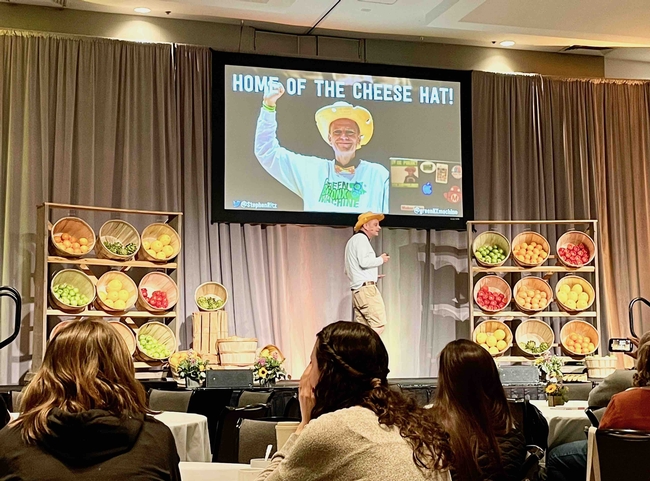
Green Bronx Machine started as an after-school, alternative program for high school students and has evolved into an organization that serves more than 50,000 students with an interdisciplinary, project-based curriculum. Green Bronx Machine also supports the Food for Others Garden on a decommissioned city street in the Bronx, a wheelchair-accessible urban farm and culinary training kitchen for special needs students, and an outdoor Learning Garden at Community School 55 among many other projects and partnerships. Truly amazing!
Upland High School Waste Audit Update
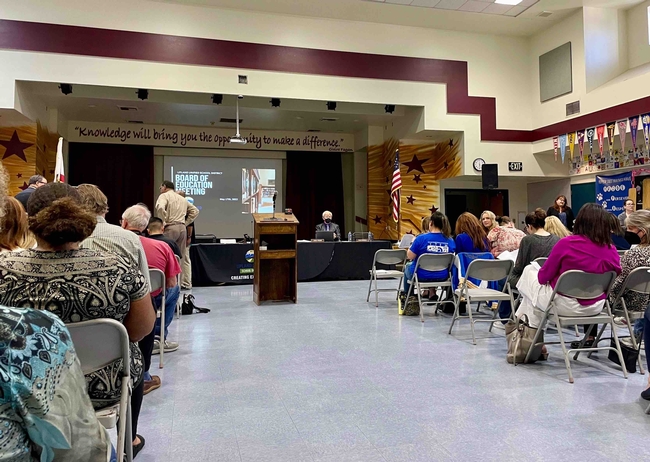
As a follow-up to the waste audit, the UUSD Nutrition Services Department is evaluating ways to collect and recycle food waste, increase education on school meal requirements, provide share buckets for unwanted items, switch to bulk condiments and sauces, and make more sustainable purchasing choices. Changes such as these will help UUSD meet the Senate Bill 1383 requirements for organic waste reduction and edible food recovery.
Have you enjoyed reading this blog? Do you have questions or need information on environmental topics? If so, send an email to dschnur@ucanr.edu. I look forward to hearing from you.
- Author: Deborah Schnur
Ever since Senate Bill 1383 took effect earlier this year, local governments and organizations across California have been scrambling to develop strategies to recycle organic waste. Schools are no exception. As I discussed in my February blog, SB 1383 requires our state to reduce organic waste disposal by 75% and increase edible food recovery by 20% by 2025 (relative to 2014 levels). California schools and universities generate over 560,000 tons of waste per year according to CalRecycle.[1] While implementing programs to reduce and recycle waste, schools are in a unique position to teach youth about a wide variety of environmental topics including resource conservation, composting, and food rescue.
A good way for schools to start developing a waste handling strategy is to conduct a waste audit. The main goal is to characterize the type, quantity, and source of materials being discarded. An audit is often part of a more comprehensive assessment to evaluate school district policies and procedures that affect waste generation. In 2014, CalRecycle performed a waste characterization study using 45 samples from K-12 schools.[2] The study showed that the largest components of the waste stream were organics (50.8%), paper (31.4%), and plastic (12.7%). The organics category included food, plant material, and some textiles.
I recently helped Cassidy Furnari, the Upland School District Farm to School Program Manager, conduct a lunchtime cafeteria waste audit at Upland High School. The Farm to School Program is part of the Nutrition Services Department, which is concerned about food waste and cost. Cassidy and I recruited members of the school garden club, GRO (Grow Recycle Organize), to participate in the audit to empower them to promote change on campus. The students are currently preparing to present their results at an upcoming Board of Education meeting.
The first step we took in planning our waste audit was to write a brief project plan. To keep the project manageable, we decided to perform an audit during a typical 30-minute lunch period. Upland High School has over 3000 students who all eat at the same time. Only seniors are allowed to leave campus during lunch.
To avoid influencing student behavior, we didn't make any major changes to the meal service or trash disposal. Rather than asking students to sort their own waste, we placed distinctive purple liners inside existing trash containers shortly before the lunch period. The week before the audit we counted over 90 trash containers in the areas where students eat lunch.
During the planning process, we informed and consulted with the school administration, cafeteria staff, custodial staff, and parents of the garden club members. We also asked for help from our friends at the Community Composting for Green Spaces Grant Program to tap into their experience with waste audits.
To design our data collection sheets, we considered what questions we wanted to answer. What is the total weight of the waste? How much of the waste is food, paper, plastic, aluminum, and glass? How much can be composted or recycled? How much uneaten cafeteria food can be recovered? By answering these questions and others, we can help the Nutrition Services Department make more sustainable and economical food purchasing and packaging decisions.
After a month of planning, the big day of the waste audit finally arrived on March 9th. Our team consisted of nine people from Upland Farm to School and Community Composting for Green Spaces. Our first tasks were placing purple bags in the trash receptacles and setting up a staging area to sort the waste. Before we knew it, the lunch period had come and gone, and the hard work of collecting the bags and sorting the waste began. Sorting was much messier and more tedious than I had expected, especially since we had over 30 waste categories. The garden club members joined us after school to help count, weigh, and record the items in different waste categories. We eventually finished tallying the results and cleaning up six hours after we started. It was a long day!
What did we learn from our waste audit? Although we're still analyzing the results, we've already answered our initial questions. The total waste generated in a single lunch period was 370 lbs. The two largest types of waste material by weight were food (63%) and paper (19%), and more than 80% of the waste was compostable or recyclable. Students threw away over 200 pieces of uneaten whole fruit and 40 unopened cartons of milk, which potentially could have been recovered. Every question we answer gives rise to new questions and new ways to examine the data. We're already thinking about performing a waste audit at an elementary school to see how the waste profile compares.
I hope this story inspires you to support waste reduction, recycling, and recovery efforts in your local schools. Stay tuned for an update on my journey into school waste auditing in a future blog!
[1] CalRecycle. School Waste Reduction Programs. https://calrecycle.ca.gov/recycle/schools
[2] CalRecycle. School Waste Composition. https://calrecycle.ca.gov/recycle/schools/composition
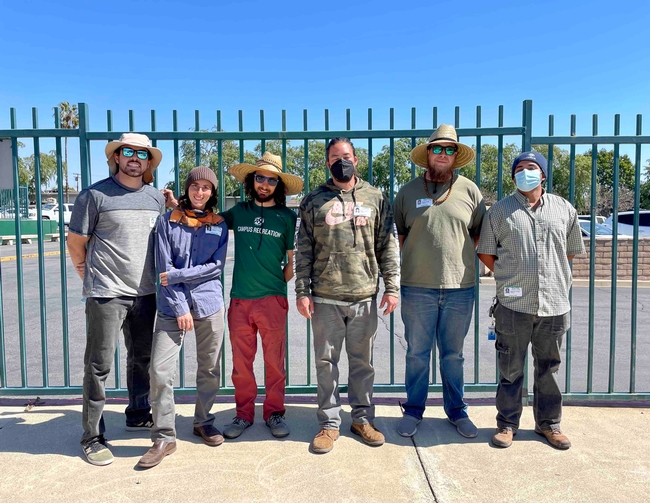
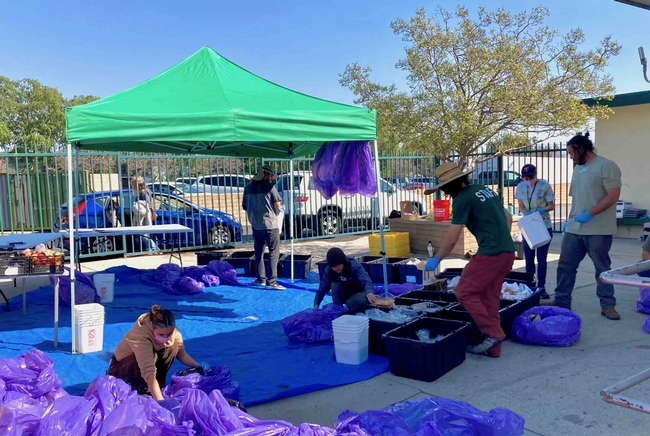
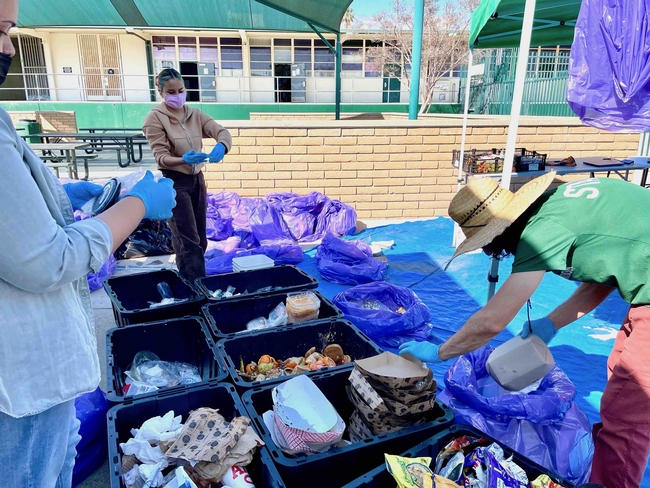
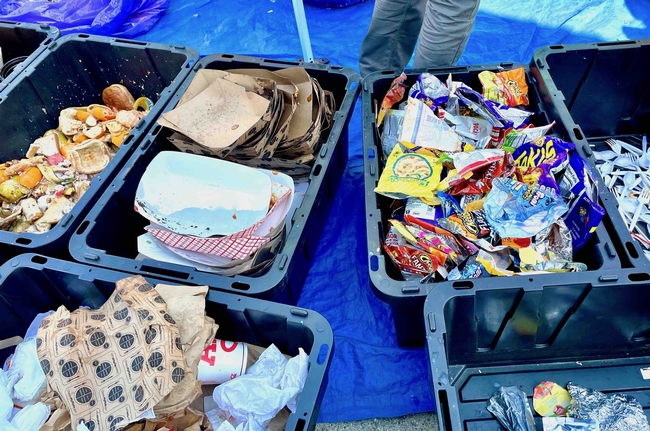
- Author: Deborah Schnur
I can't believe I've been working part-time as the UCCE San Bernardino Environmental Education Coordinator for six months already! As the saying goes, “time flies when you're having fun”. I was having so much fun that I started a second part-time position as the Farm to School Program Assistant for the Upland Unified School District (UUSD) at the end of January. Through these two positions, I hope to build stronger partnerships between UCCE and local schools.
In this month's blog, I want to introduce you to the UUSD Farm to School Program. The program is part of the Nutrition Services Department. Cassidy Furnari, the Program Manager, has been working with UUSD for over three years during which she's made tremendous progress building school gardens and providing hands-on learning opportunities. The district has 14 schools, 11 of which have gardens for the students. By the end of this school year, all schools will have gardens.
Cassidy started as an intern when she was completing her Master of Science degree in Regenerative Studies at Cal Poly Pomona. I first became acquainted with Cassidy when I served with FoodCorps at Phelan Elementary and two members of my cohort served at Upland schools. UUSD still supports two FoodCorps service members.
Rather than using a cookie-cutter approach, Cassidy aims to customize each school garden to match the school community and the school's goals and resources. Before doing anything else, she gets to know the entire school community—the administrators, staff, teachers, students, and parents—because she believes the most successful gardens come from community ideas. The more the community is included in the garden, the more sustainable it will be. Both community volunteers and the UUSD Maintenance and Operations Team are instrumental in building the gardens and bringing them to life.
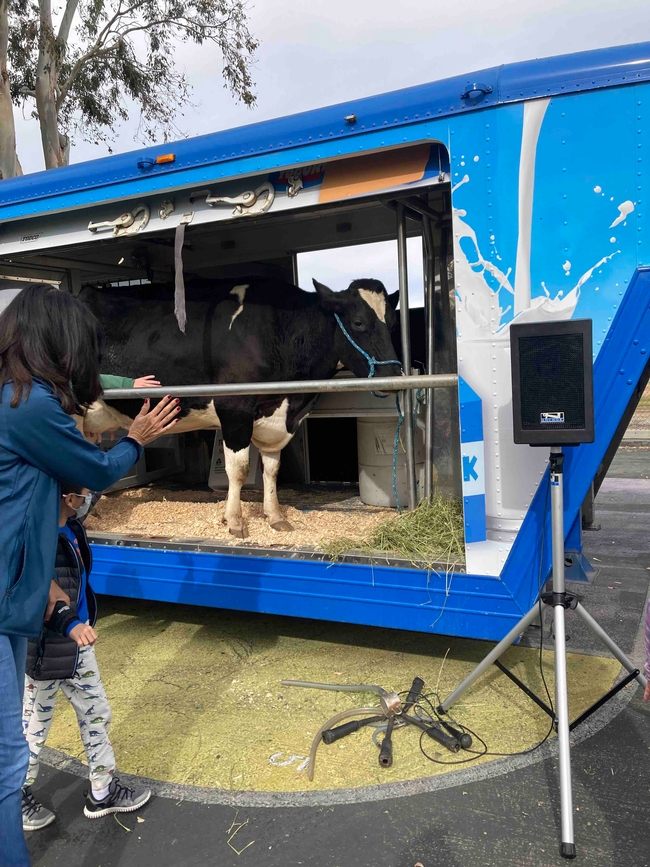
Once the garden is up and running, the Farm to School Program grows organic seasonal produce for students and their families. All UUSD schools are registered as community food producers; so everything grown in the gardens can be served to students in the cafeterias. Cassidy is most excited about the cafeteria taste tests because they help students connect with the food being grown. One example was an eggplant dip taste test at Upland High School; the eggplant, garlic, onion, basil, and tomatoes used to make the dip were all grown on site. At Foothill Knolls STEM Academy, garden basil was turned into pesto for a taste test. Cassidy wants to show the students that their opinion matters and will be reflected in the cafeteria menu. Before the COVID pandemic, the cafeteria staff also added school-grown produce such as broccoli, radishes, carrots, and citrus to the salad bar. When schools shut down during COVID, produce bags containing lettuce, cabbage, herbs, citrus, and other fruits and vegetables were distributed to school families.
The Farm to School Program also provides a space for community and family education and engagement. Social media posts on YouTube and Instagram include cooking demonstrations and a recap of the week's activities. The program plans to make lessons and curriculum available to the school community through its website. In partnership with UUSD Support Services, the program will offer a stress management and eating course in the next month.
Planning for sustainability is critical to the continued success of Upland's Farm to School Program. This is accomplished by giving students and teachers agency over garden spaces and holding volunteer days to connect school communities with their gardens. The longer term plan is to train interested teachers to take care of the gardens and integrate them into their lessons. Garden sites are built for sustainability by completely removing the sod, laying down landscape fabric and substrate such as decomposed granite, and adding an extra layer of fabric underneath the garden beds.
Another aspect of sustainability is funding. Over the years, Cassidy has become a prolific grant writer. Thanks to her efforts, the UUSD Farm to School Program has received grants from the USDA (U.S. Department of Agriculture), CDFA (California Department of Food and Agriculture), Sprouts, Whole Foods, Lowe's, Action for Healthy Kids, Walmart, and California Fertilizer Foundation.
I'm proud to be associated with such a strong and vibrant Farm to School Program and believe it's the perfect complement to my work at UCCE. I look forward to spending sunny days in school gardens with curious and energetic students. This is what makes my heart sing. I hope you too find your happy place in the garden!
